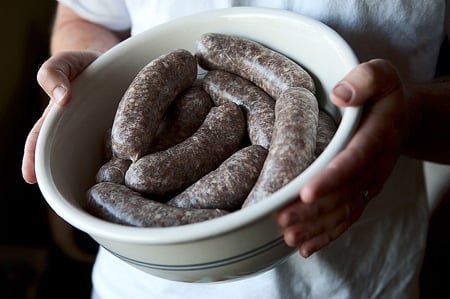
This is a sausage I was inspired to make after I returned from a deer hunting trip to Catalina Island. I am a firm believer in the cooking adage, “what lives together in life can live together on the plate.” We found lots of native sages on the island, and where I shot this deer we found a hedge of black sage.
If you can find California white sage or black sage, by all means use it. It’s what I used in this recipe. But regular sage works just fine.
As you might guess, the two main players here are sage and juniper, boosted by the juniper-herbiness of gin. It makes this sausage taste like the hillsides of California smell on a warm summer’s day. I add a touch of celery seed, too, which seems to punch up the taste of the venison.
If you can’t find venison, although you can buy ground venison online, use beef or lamb. Elk, moose, antelope or wild sheep also work fine, and honestly, wild boar or even good quality pork would still taste good.
How to cook these sausages? Grill slowly, or brown in a pan, then pan roast at 325°F for 20 minutes. You can also use these links in a stew, or in a helluva sausage, peppers and onions sandwich.
Note that you will only need the Instacure if you are smoking these sausages.
If you’ve never made sausages before, or want to bone up on basic technique, I wrote a tutorial on my friend Elise’s site, Simply Recipes, that can be found here.
Makes 5 pounds, about 20 to 22 links
- 4 pounds venison (or antelope, elk, moose, or beef)
- 1 pound pork fat (beef fat is OK, too)
- 33 grams Kosher salt (about 2 tablespoons)
- 3 grams Instacure No. 1 (optional)
- 15 grams ground juniper berries (about a tablespoon)
- 25 grams fresh chopped sage (about 2 tablespoons)
- 1 tablespoon ground black pepper
- 3 grams celery seed (about 1/2 teaspoon)
- 1/2 cup gin
- 1/4 cup cold water
- Hog casings
- Chop venison and pork fat into 1-inch chunks, or however big you need to fit into your grinder. (Expert step: Mix the salt and curing salt with just the meat and refrigerate overnight. This helps develop myosin, which helps bind the sausage better later.)
- Take out about 10 feet of hog casings and set in a bowl of warm water to rehydrate.
- If you haven’t already done so, combine the salt, curing salt, herbs and spices with the meat, mix well. Chill the meat and fat until it is almost frozen by putting it in the freezer for an hour or two.
- Grind through your meat grinder using the coarse die; I use an 8 mm or a 10 mm die for this. If your room is warmer than 69°F, set the bowl for the ground meat into another bowl of ice to keep it cold. Put the mixture into the freezer while you clean the grinder, then submerge the auger, die and blade into ice water to chill it down. Now grind a second time through the fine die; I use a 4.5 mm for this.
- Return the mixture to the freezer until it is very cold, about 32°F. When it has chilled sufficiently, add the gin and cold water and mix thoroughly either using a Kitchenaid on low for 60 to 90 seconds or with your (very clean) hands; I use my hands, which should ache with cold as you do this.
- Stuff the sausage into the casings. Twist off links by pinching a link and twisting it, first in one direction, and then, with the next link, the other direction. Or you could tie them off with kitchen string.
- Hang the sausages in a cool place. In a normal room, hang for 2 hours. But if you have a place where the temperatures are between 33°F and 40°F, hang up to overnight. Once the links have dried a bit, put them in the fridge until needed. They will keep for at least a week. You can also smoke these sausages to an internal temperature of 150°F.
